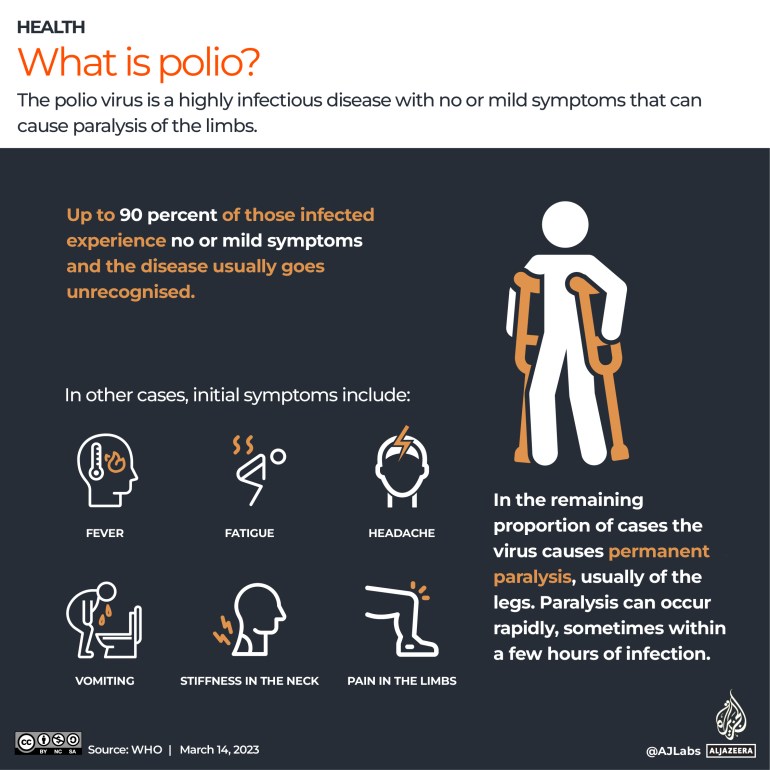Health workers this week launched a vaccination drive to protect 9.5 million children against polio in 41 districts across Pakistan. This latest phase of the national vaccination drive will include Islamabad and focus particularly on areas where polio-positive sewage samples have been found.
According to local media, the polio eradication drive will be launched in 16 districts of Balochistan, 11 districts of Khyber Pakhtunkhwa, eight districts of Sindh and five districts of Punjab.
Despite massive efforts to eradicate the disease in Pakistan, six cases of the highly contagious virus have already been reported this year. Vaccination teams and medical professionals have faced harassment and even physical attacks in parts of Pakistan, hampering the drive.
However, Pakistan Prime Minister Shahbaz Sharif said after a meeting with US billionaire Bill Gates in Islamabad last week that the government was “resolute” in its goal of eradicating polio.
How serious is polio a problem in Pakistan?
According to the World Health Organisation (WHO), Pakistan is one of only two countries in the world where polio is still endemic, the other being neighbouring Afghanistan.
This highly contagious viral disease mainly affects children under the age of five. Children infected with the poliovirus can become paralyzed and in some cases, even die.
The South Asian nation launched the vaccination programme in 1994 as part of its polio eradication programme. Officials say the country used to see more than 20,000 cases annually.
Despite administering over 300 million oral vaccines annually and spending billions of dollars, the disease is still prevalent throughout Pakistan.
This year, four vaccination campaigns have already been carried out targeting more than 43 million children, as authorities claim they are in the “final stage” of their fight against polio in the country of 235 million.
How many cases have been reported in Pakistan?
Pakistan has reported 357 polio cases since 2015, six of them this year. One of the victims, a two-year-old boy, died in May.
All this year's cases belong to the YB3a group, which originated in Afghanistan, where four cases have been reported this year, officials said.
In addition to human cases, wild poliovirus type 1 (WPV1) has been frequently detected in environmental samples taken across the country. This year, WPV1 has been detected in 45 of Pakistan's 166 districts.
How does Pakistan conduct its polio immunization campaign?
More than 350,000 health workers have been involved in the vaccination drive across the country. Under this campaign, vaccine desks have been set up at health centers and health workers are doing door-to-door vaccination. The campaign is organized by the government-run National Emergency Operation Center (NEOC), which is tasked with running Pakistan's polio eradication program.
Field workers go door-to-door on scheduled days to immunize children under five years of age.
Vaccines are also administered at land and air borders, including to adults, and on highways connecting major cities across the country.
What are the issues facing the polio campaign?
Resistance to the polio vaccination drive in Pakistan grew after the US intelligence agency CIA ran a fake hepatitis vaccination campaign to track down al-Qaeda leader Osama bin Laden, who was killed by US special forces in Pakistan in 2011.
Misinformation linked to religious beliefs has also been spread, including claims that the vaccine contains pork and alcohol, which are prohibited in Islam.
Misinformation, agenda-driven campaigns, myths, community exclusion and mistrust in the government have also been factors behind the denial. But officials say government campaigns are helping change misconceptions.
Health officials in Pakistan have listed seven districts where polio is “endemic”. All seven districts are in Khyber-Pakhtunkhwa province, in the northwest. Officials said the security situation in the province bordering Afghanistan has been the biggest obstacle to reaching the target population.
In addition to the security situation, health officials say the movement of the target population from one place to another, which may carry the YB3A variant, has proven to be a challenge.

Why were health workers and security officials targeted?
Healthcare workers and accompanying security officials have been harassed, ridiculed, taunted, threatened, and even physically targeted.
At least 102 polio workers, officials and security personnel have been killed, at least six of them in campaigns this year.
In recent years, the Pakistani Taliban have killed dozens of health workers and members of the security forces involved in the polio campaign. But officials believe the violence is not solely driven by the polio program.
“In the last few years the polio programme has not been targeted but unfortunately the security personnel who protect the teams have been targeted because given the security situation in some parts of the country, when they are in the community they become easy targets,” Dr Hamid Jafari, the World Health Organisation’s polio eradication director, told Al Jazeera.
What other issues affect healthcare workers?
Low wages, delay in salaries, lack of support and sympathy and difficult working conditions are some of the other problems faced by the field workers.
Some health workers told Al Jazeera they are paid just 1,360 rupees (about $5) a day for working a minimum of eight hours a day. They said they are not paid when they go to the field to vaccinate children who were left out after the vaccination campaign is over.
Additionally, some polio victims working on the campaign are unable to access transportation or recovery assistance due to their poor condition, leaving them to complete their work on foot through inclement weather and difficult terrain.
Some staff lamented the lack of pay equality, saying those working with international organisations involved in the campaign were paid much more.

What is the scenario of polio eradication campaign?
Dr Shahzad Baig, who headed the NEOC until May, told Al Jazeera that its goal is to make Pakistan polio-free by 2026.
“That's our goal right now,” he said before being removed from his post.
However, according to a report in Pakistan's Dawn newspaper, following a WHO-hosted technical advisory group meeting in Qatar in May, concerns are growing about the “worsening disease situation” in the country.
The report quoted a Pakistani official as saying at the meeting, “We are faced with an embarrassing situation as all the gains made by Pakistan in 2021 have been lost and the virus has re-emerged in the three blocs.”
Health officials are hopeful, however, as the number of positive cases has dropped significantly over the past five years — from 147 in 2019 to six so far this year.
“The programmes in Pakistan and Afghanistan are very mature and a lot has been learnt from them,” Jaffrey said.
“Despite changes in government and security situations, these programmes have evolved, adapted and adjusted. And that's why they have a level of population immunity that you're not seeing outbreaks of paralytic polio cases.”
“This is not a Pakistan-wide problem. It's not even a broad geographical problem. It's now a matter of reaching those last, hard-to-reach populations. When you start to reach these populations, progress happens very quickly.”













